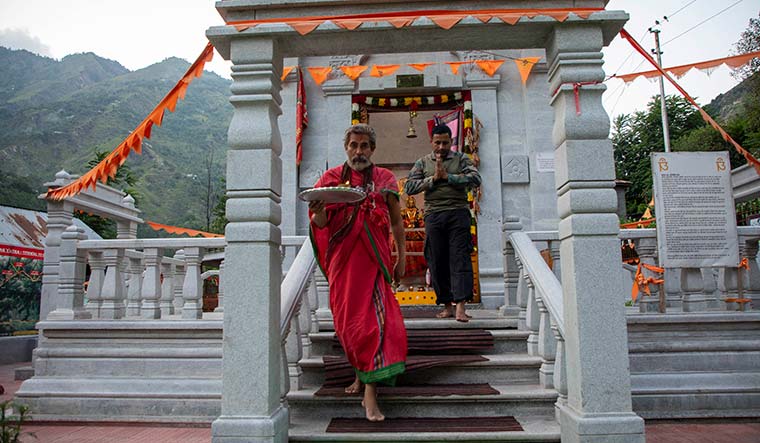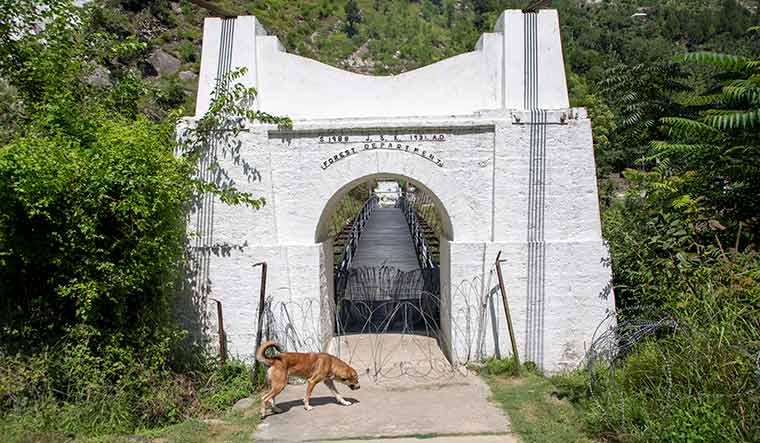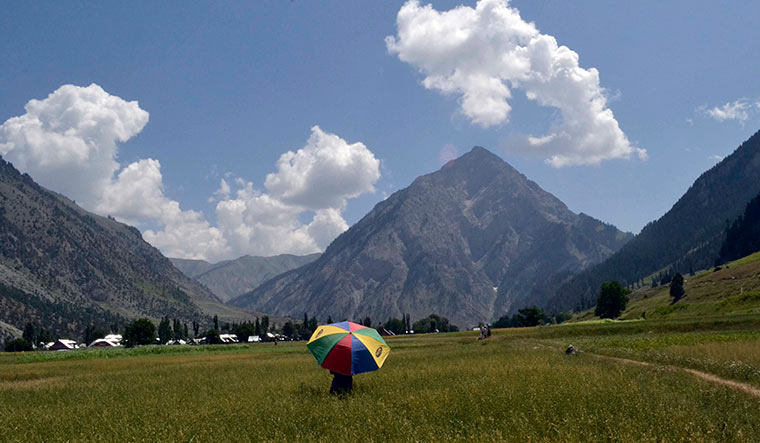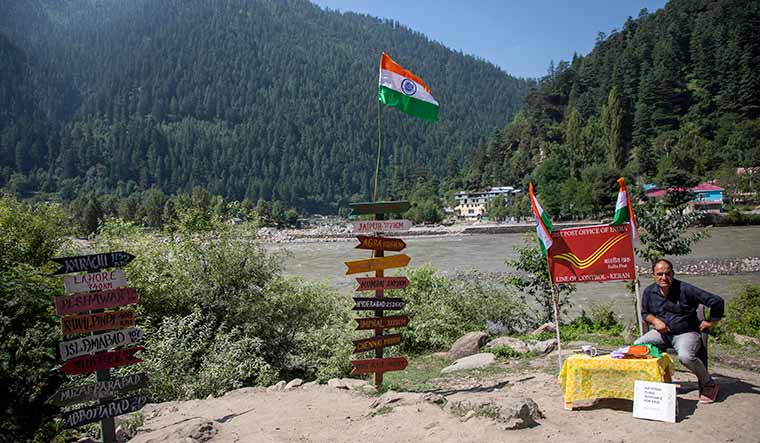Last summer, a group of young tourists visited Suhail Ahmed Khan's residence at Keran village in Kashmir's Kupwara district. Situated on the banks of the Kishanganga river, Keran is about 135km from Srinagar. Part of the village stretches to the other side of the river in the Neelam valley of Pakistan-occupied Kashmir. Across the Line of Control, the river is called Darya-i-Neelam (the river Neelam).
The young travellers reached late in the night and were looking for a place to stay. Pleasantly surprised, Khan gave them a spacious ground-floor room, and offered them dinner. But they wanted just some tea. "I woke up my wife, and she made tea and makki ki roti (flatbread made from maize flour)," said Khan. The guests ended up spending four days with him. Later, they shared a video on YouTube about their time in Keran, praising Khan and his family for their hospitality and mentioning his phone number. Before long, Khan, who runs a pharmacy at the local hospital―the only place in the village with internet access―began receiving inquiries. Now there is a signboard outside his residence: "Suhail Guest House".
Keran and other areas with untapped tourism potential along the LoC, such as Teetwal, Bangus and Machil in Kupwara and Gurez in Bandipur, remained isolated from the outside world because of decades of turmoil. These areas were on the primary infiltration routes from Pakistan in the 1990s. For livelihood, the local people looked for government jobs and work as army porters. These areas were opened up for tourism after India and Pakistan announced a ceasefire along the LoC in February 2021, sparking optimism among local people. The government's decision signified at least a semblance of normalcy in Kashmir after the instability caused by the revocation of Article 370. It also holds the potential to bring these unseen gems to the tourist map and improve the lives of local people.
Keran is nestled amid picturesque meadows, verdant forests, meandering streams, bubbling springs, majestic walnut trees and diverse wildlife. A major attraction for tourists is the panoramic view across the LoC into the Neelam valley, where residents have constructed modern houses, hotels, restaurants and picnic spots accessible through well-maintained roads and reliable mobile connectivity. Both local people and visitors gather along the banks of the river, exchanging gestured greetings with those in Keran. Most residents in Keran and the Neelam valley are relatives separated by the LoC. On weekends, the influx of tourists increases significantly. After dusk, the entire valley lights up, creating a spectacle amid the cool breeze wafting in from the Kishanganga.
Overcoming the inadequacy of infrastructure in Keran, local residents have converted their houses into affordable homestays. Additionally, there is the option for camping tents. Some travellers set up camps along the riverbank, and cook using portable gas stoves. Others use the readily available firewood. Khan has plans to put up tents on a vacant half-acre plot in front of his house next month, when the maize crop will be ripe. “After that, we will have all amenities,” he said.
 Divine presence: The Sharda Peeth temple in Teetwal | Umer Asif
Divine presence: The Sharda Peeth temple in Teetwal | Umer Asif
An inconvenience for travellers is the lack of internet and mobile connectivity. Sidiq C.H. and Adil Abdul Razal, who came from Kerala, said they could not make online payments. "Nobody carries cash in this digital era. Internet is a must," said Sidiq. Razal said people from both sides of the river should be allowed to meet and interact freely. Shafqat-ul-Islam, from Pattan in Baramulla, said ATMs, too, should be provided in the area. A favourite tourist destination in Keran is “India's first post office” (the first post office from the LoC), a quaint single-storey wooden structure.
Local people in Keran argue that the government should have constructed the Sharda Peeth temple in their village, instead of in Teetwal. "From Keran, the Sharda Peeth is just 26km away, while it is 47km from Teetwal," said a resident. The Sharda Peeth was a historical centre for learning and worship, dedicated to the goddess Saraswati. The ruins of the ancient site lie in the Neelam valley in PoK. The new temple at Teetwal was inaugurated virtually by Union Home Minister Amit Shah in March. He assured the Kashmiri Pandits that the government would establish a Sharda Peeth corridor akin to the Kartarpur corridor in Punjab.
Teetwal is also on the Kishanganga, close to the LoC. Located 167km from Srinagar and 82km from Kupwara, it is endowed with striking natural beauty. The road from Kupwara to Teetwal traverses narrow, rugged terrain, offering beautiful views of mighty mountains, lush valleys and lively streams. Teetwal also lies divided between India and Pakistan. The part of the village in PoK is called Chilihana.
 The footbridge across the Kishanganga which connects Teetwal and Chilihana | Umer Asif
The footbridge across the Kishanganga which connects Teetwal and Chilihana | Umer Asif
Teetwal residents say the Sharda temple was built in their village because of its alignment with the traditional route to the Sharda Peeth. The construction was supervised by the Save Sharda Committee, predominantly managed by local people. Historically, the temple's site served as a base camp for pilgrims travelling to Sharda Peeth, and it once hosted a gurdwara as well. After the tribal invasion from Pakistan during the time of independence, local Muslims protected the property and returned it for the temple's reconstruction after 75 years. Alongside the temple, the gurdwara, too, was rebuilt.
"Our elders had instructed us to safeguard the land for Hindus and give it back whenever they returned," said Ajaz Ahmed Khan, a local member of the Save Sharda Committee. "The credit goes to Ravindra Pandita, head of the Save Sharda Committee, who relentlessly dedicated his efforts to this endeavour."
The temple's construction stands out, owing to the intricate use of meticulously carved granite stones from Karnataka. The temple has attracted Kashmiri Pandits and other devotees from various corners of India. It has also rejuvenated Teetwal's historical significance and amplified tourist inflow. One of Teetwal's landmarks is the Teetwal crossing point, where an architecturally appealing footbridge across the Kishanganga connects Teetwal and Chilihana. The bridge was one of the five authorised crossing points for families separated by the LoC, which were opened as part of a joint decision between India and Pakistan in 2005. In 2018, these crossing points were closed because of allegations of terror activities.
 High and mighty: Habba Khatoon, a 13,000-ft peak in the Gurez valley | Umer Asif
High and mighty: Habba Khatoon, a 13,000-ft peak in the Gurez valley | Umer Asif
Gurez valley is another upcoming tourist attraction. Located 140km from Srinagar, it has remained relatively unexplored because of its proximity to the LoC. The valley has endured decades of firing and shelling from Pakistan, which has limited its exploration. The route to Gurez passes through a rugged pathway marked by steep inclines and the 11,672-foot-high Razdan Pass. The central hub of administration and business in the valley is Dawar. Dominating the horizon is Habba Khatoon, a 13,000-ft peak named after a 16th-century poet. According to local legend, Habba Khatoon, known as the nightingale of Kashmir, spent her youth at the base of the mountain that now carries her name. It rises like a pyramid above the valley, consisting of a dozen villages. Tarbal, the last village before the PoK, is on the banks of the Kishanganga and serves as a camping site for tourists.
With improved infrastructure, Gurez possesses the potential to compete with popular tourist destinations like Gulmarg and Pahalgam. Its distinct landscape, the roaring Kishanganga and various trekking opportunities contribute to its appeal. The road through the valley offers captivating views of maize fields, while the villages with their exquisite wooden houses create a fairytale atmosphere.
The inhabitants of Gurez, known as the Dard Shin tribe, speak Kashmiri and have a unique history. In the past, their influence extended from northern Afghanistan to central Tibet, encompassing regions like Chitral, Gilgit, Chilas, Bunji and Drass. Gurez was a historical stop along the Silk Route, and the valley has rekindled its allure as it connects Kashmir with Kashgar in Central Asia. It attracts a diverse crowd of tourists, off-roaders and nature enthusiasts.
 A view of the Neelam valley in PoK from the Indian side | Umer Asif
A view of the Neelam valley in PoK from the Indian side | Umer Asif
Despite the advantages that Gurez enjoys, several challenges remain. Sheikh Mohsin, a local inhabitant, is unhappy that tourists are not allowed to stay overnight in certain parts of Gurez. Night stays across the valley, he said, would significantly improve tourism prospects. A university student, he said, educated young people there had very few employment avenues. “Government backing for tourism could pave the way for substantial job opportunities,’’ he said. Another young resident, Shabir Ahmed Lone, who holds an engineering degree, said the suspension of overnight stays came into effect after the security forces in the area caught a militant. "Despite attaining my BTech degree, I rely on tourism for my livelihood," said Shabir. He said the poor state of roads was deterring tourists.
For security reasons, visiting places along the LoC requires prior permission. Travellers from outside Jammu and Kashmir can apply online and receive clearance within 24 hours. J&K residents need only present an Aadhaar card or a driving licence and fill a simple form and get it stamped by the police. The process usually takes less than 20 minutes. No permission is required for getaway locations in south Kashmir.
One such unspoiled destination is Daksum in Anantnag, around 100km from Srinagar. The scenic spot boasts dense forests of pine, oak and deodar, freshwater springs and verdant pastures. It is notably less crowded than other tourist spots. The surrounding forests and hills offer ample opportunities for trekking through pristine wilderness, making it a popular choice for adventure enthusiasts. A herbal garden and the Rajparian Wildlife Sanctuary provide a tranquil escape.
Also read
- How Kashmiris are slowly opening their hearts and minds to new thoughts
- CID DG R.R. Swain: Valley’s own commando
- PWD Principal secretary Shailendra Kumar: Paving road to peace
- Athar Aamir Khan, commissioner, Srinagar Municipal Corporation: Keeping Kashmir smart
- J&K Sports Council secretary Nuzhat Gull: The people's champion
- IT secretary Prerna Puri: Transforming with technology
College students Shahid Bhat and Shahid Wani, both hailing from Naubugh in Anantnag, have seized an opportunity to earn a livelihood, given the steady stream of visitors to Daksum. They are active members of a cooperative of unemployed educated young men and women who collaborate with the tourism department in Daksum. Bhat said Daksum was home to one of the largest sheep farms in Kashmir, where various breeds were reared in their natural habitats. "Some tourists express a keen interest in witnessing this unique aspect of Daksum," he said. Last year, a group of female foreign tourists who came to Daksum specifically requested for female guides. “After that, we included female members in our cooperative,’’ said Wani.
The government's decision to relax travel restrictions in Kashmir's uncharted landscapes aims at highlighting the return of peace after the controversial decision to revoke J&K's limited autonomy and statehood. The move has evoked a favourable response among local people, especially the younger generation which has no idea about life in the region before the late 1980s when the valley slid into violence. It is proving beneficial for the local population and tourists, as it encourages them to explore Kashmir beyond its well-known destinations. The initiative has also revived Kashmir's sobriquet as 'paradise on earth'.


